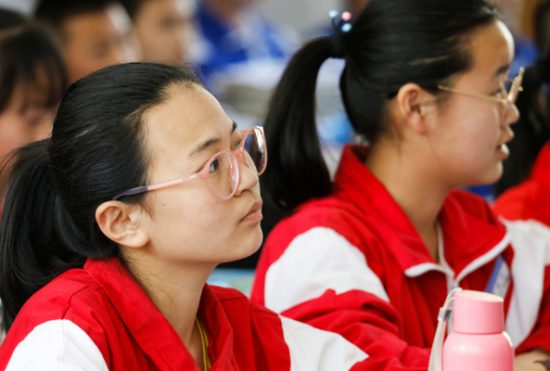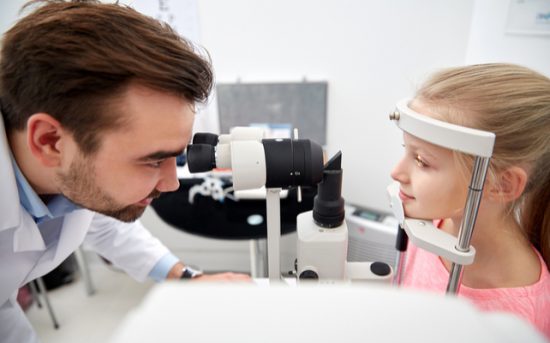Myopia, or nearsightedness, has reached epidemic proportions in parts of Asia. The National Eye Institute warns that by 2020, 39 million Americans will be nearsighted, and that the figure will grow to 44.5 million by 2050. The myopia epidemic begins with children and teenagers, so that some call it the childhood myopia epidemic. Mild to moderate cases of childhood myopia tend not to have any serious long-term effects on health or vision. Progressive myopia, on the other hand, comes with a higher risk of serious complications including detached retina and glaucoma.
In myopia, the eyeball is either too long from front to back, or the cornea, the clear covering of the front of the eye, has a steep curve. This changes the way light rays land on the eye. When all works as it should, light rays find their way to the retina. The retina is light-sensitive tissue at the back of the eye.
In myopia, the different shape of the eye changes its slope, causing light rays to fall just in front of, instead of directly on the retina. The result is a change in vision. Myopia means that objects that are close up are seen clearly, while faraway objects are blurry.

For most people, nearsightedness gets worse over time. Glasses and contact lenses are used to restore normal vision. For those looking for a more permanent solution, surgery may be a good option.
The Myopia Epidemic
The extent of the myopia epidemic in Asia is striking. Back in the 1950’s just 10-20 percent of the population in China had myopia. Now, as many as 90 percent of teenagers and young adults are nearsighted. It’s not just China, either. In Seoul, 96.5 percent of 19-year-old men are nearsighted.

Asia may have seen the worst of the myopia epidemic, but nearsightedness is also affecting the West. Half of all young adults in the United States and Europe are nearsighted. That’s double what it was 50 years ago. Some experts think that as many as one-third of the entire world population, 2.5 billion people, may have myopia by 2020. And it’s mostly happening to our young people.
Myopia Risk Factors for Children
Myopia is, in part, something a child inherits from his parents. But myopia can also develop from pollution in the environment or from stress on the eyes. Spending long hours reading, doing close work like embroidery, or working at a computer screen, are examples of activities that stress the eyes, and may cause or worsen nearsightedness. Spending 2 hours a day outside, on the other hand, can stop myopia from getting worse.
Here is a list of risk factors for myopia and myopia progression from the American Academy of Ophthalmology:
- Near work or visual activity that forces the eyes to keep near objects in focus
- High level of education
- Low levels of outdoor activity
- Diet
- Television
- Computer games
- Electronic devices
- Pollution
- Female gender
- Season of birth/daylight hours
- Parents are nearsighted
- Use of a night light
- Younger age at diagnosis
- High IQ score
Myopia And Free Radicals
There is evidence that oxidative stress inside the eye causes eye problems, including nearsightedness. This type of stress can increase the amount of something called reactive oxygen species (ROS) in the eye and in the retina, in particular. ROS is a type of unstable molecule or free radical, that interacts with other molecules and contains oxygen. Too much ROS can cause damage to DNA, RNA, and proteins, and may even cause cell death. The retina has continuous exposure to light, and this causes a buildup of ROS.
Antioxidants are known to fight eye problems caused by oxidative stress. Eating a diet rich in antioxidants can help stop the progression of myopia. For this reason, kids should eat foods containing vitamins A, C, and E; beta carotene; and zinc/copper.
Zinc is of particular importance to the retina. Not getting enough zinc can damage eye tissues and other structures important to the eyes. Too much zinc can cause a copper deficiency, so you want your child to eat foods that contain both copper and zinc. Foods containing copper and zinc include seafood, beef, beans, and seeds.

Myopia: Genes Or Lifestyle?
Experts used to believe that developing myopia was all in the genes. A study from 1963, for instance, found that nearsightedness is more common in identical twins than in non-identical twins. This would suggest that DNA plays a big role in who develops myopia. Since that time, scientists have found over 100 regions of DNA that can be linked to myopia.
It was obvious, on the other hand, that myopia was caused by more than genes. A 1969 study of Inuit people in Alaska showed that lifestyle changes may be causing myopia. Of the 131 adults in the community, just two were nearsighted. But over half of the children and grandchildren of this community were found to be nearsighted. It was clear they weren’t inheriting the condition from their parents and grandparents. Something else was going on.
Researchers figured the difference might have to do with reading. It’s not a new idea. Moms have always told children not to read in dark rooms and to give the eyes a break every once in awhile. And in fact, over 400 years ago, Johannes Kepler, a German astronomer and optics experts, said he’d become nearsighted because of all his studying and book-learning. Leading ophthalmologists of the 1800s recommended that students use headrests to create a distance between the eyes and a book’s text. This was meant to prevent reading too close, which was thought to strain the eyes.
Myopia And Reading
The myopia epidemic does seem to be connected to reading, but it’s not so much about reading books. Today, kids are spending most of their time reading from computer and smartphone screens. That’s also true in East Asia, but kids there aren’t just chatting and going on social media: they’re using computers and smartphones to study, too.
Just how much are the kids in Asia studying? A report from 2014 by Organisation for Economic Co-operation and Development (OECD) found that the average 15-year-old in Shanghai spent 14 hours a week on homework, compared with 6 hours in the United States, and just 5 hours in the United Kingdom.
Anywhere that there is a focus on education, you’re going to see lots of myopia. In the 1990s in Israel, for example, teenage boys who studied in yeshiva seminaries had higher rates of myopia than their peers. In seminaries, the boys spend the entire day, every day, studying religious texts. Taken on the face of things, it did seem to researchers as though reading up close for long periods over time may change the shape of the eye and the way light hits (or doesn’t hit) the retina.

But the idea was myth-busted when, during the early 2000s, researchers tried to find a link between myopia and the number of books read each week or hours spent using computers. These factors, as it turned out, didn’t seem to be the main contributor to a young person becoming nearsighted. In 2007, however, the light went on, so to speak. That’s when researchers figured out that kids in California who became nearsighted had stopped spending time out of doors. A year later, a much larger study done in Australia of 4,000 Sydney children over three years’ time, found that the kids who spent less time outside had a higher risk for developing nearsightedness.
Myopia And Natural Light
Why is it so important for kids to spend time out of doors? It has to do with getting enough natural daylight. It seems that indoor light is always going to be less bright than outdoor light. The natural light outside is brighter than the most brightly lit indoor room, even on the cloudiest days. Light bulbs just can’t compete with Mother Nature.
In the winter, kids may be less inclined to play outside. It’s also true that the days are shorter during the colder months. That may be the reason that more kids become myopic in winter than in summer. There’s just less exposure to natural light at that time.
It’s not just the natural light that helps preserve eyesight and prevent nearsightedness. Being out of doors means being in wide open spaces. That means that the eyes have more room to focus. That’s better for vision than being in an indoor room that forces the eyes to focus at shorter distances.
Kids at risk for myopia should try to spend 14 hours a week out of doors. That’s about two hours a day. And of course, if they can spend more time out of doors, they absolutely should.

Here are some recommended outdoor activities:
- Sports (baseball, basketball, tennis, and etc.)
- Walking the family dog
- Hanging out in parks
- Hiking
- Riding a bike
Balancing Study Periods With Rest
Kids can’t be outside all day and they do have to study. That’s why it’s important to limit the amount of time spent doing close work. Kids should also take a break from close work every half an hour. During these breaks, if they can’t go outside, kids should at least look out the window to give their eyes a rest. When kids are reading, watching television, or using computer and phone screens, they should have good light and not sit too close to books and screens.
Natural sunlight seems to be the simplest solution to avoiding childhood myopia, or prevent it from worsening. But researchers have been working on other means to stop childhood myopia from getting worse. There are corrective lenses that reshape the eyes. There’s also research to suggest that using atropine eye drops at night may help to get myopia progression in children under control. The problem is that researchers don’t yet know why these drops help. What they do know: atropine is known to block neurotransmitters.
The upshot of all this research on childhood myopia? Balance study time with time spent resting the eyes. Have children go outside as much as possible, at least two hours a day. When children are studying, make sure there’s good light and that they don’t sit too close to their work
Childhood Myopia And Eye Exams
Beyond all that, make sure your child has an eye exam once a year, so the doctor can see if or how your child’s eyes are changing. That should be on a parent’s to-do list whether or not a child complains about his vision. Kids generally don’t complain about being nearsighted. They just figure out how to make do.

Do you think your child may be at risk for becoming nearsighted? Bring your child to an eye doctor as soon as possible. Finding and treating myopia is still the best way to keep your child from becoming a statistic in the childhood myopia epidemic.
Found what you just read useful? Why not consider sending a donation to our Kars4Kids youth and educational programs. Or help us just by sharing!
